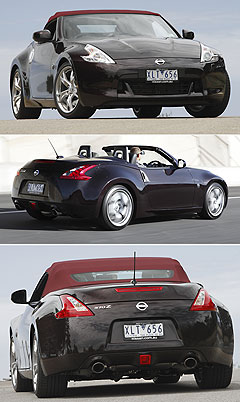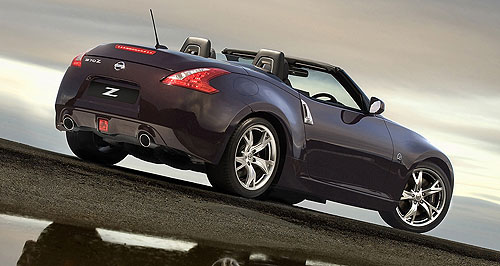Make / Model Search
New models - Nissan - 370Z - RoadsterFirst drive: Nissan lands its new 370Z RoadsterNew softie: Soft-top version of cracking new 370Z Coupe arrives with a smaller $7000 premium than before. Long-awaited Nissan 370Z Roadster arrives, priced from $74,990 and packing value26 Feb 2010 By TERRY MARTIN ALMOST 12 months after the much-anticipated 370Z Roadster was revealed at the New York auto show in April 2009, Nissan has finally brought the beautiful soft-roofed sportscar Down Under. Launched in New Zealand this week, with Australian deliveries beginning on March 1, the Roadster has arrived with a $7000 premium over the tin-lidded 370Z Coupe, priced from $74,990 (plus dealer delivery and statutory charges). That money buys a close-ratio six-speed ‘SynchroRev Match’ manual transmission that automatically blips the throttle when changing gears, while the new seven-speed ‘Downshift Rev Matching’ automatic with sequential-manual mode and paddle shifters costs a further $3000. As with the Z coupe, which arrived in Australia last May, the front-engined rear-drive two-seater roadster has at its heart the now-familiar VQ37VHR 3.7-litre DOHC petrol V6 (with Variable Valve Event and Lift Control, or VVEL) delivering 245kW of power at 7000rpm (redline: 7500rpm) and 363Nm of torque at 5200rpm. This is a considerable improvement, particularly in power terms, over the previous 350Z’s 230kW/358Nm 3.5-litre 35HR version of the VQ-series engine. Nissan Australia has not released performance figures, but official statistics from overseas versions claim the new 370Z Roadster can accelerate from to 100km/h in 5.5 seconds in manual form, with the auto reaching the mark in 5.8 seconds. Both have a maximum speed of 250km/h. The coupe, in comparison, is a little lighter – to the tune of 60kg for the manual, 55kg for the auto – and can reach 100km/h from standstill in 5.3 seconds, or 5.6 seconds with the auto. It has the same top speed. As we saw with the introduction of the 370Z Coupe, the roadster is around 25kg lighter than its predecessor – tipping the scales at 1608/1618kg manual/auto, thanks to measures such as an aluminium bonnet, door panels and bootlid – and, as such, offers better fuel consumption. The manual returns an 11.2L/100km average (1.2L less than the 350Z), while the auto has a better mileage with 10.9L/100km (down 0.8L over the previous five-speed version). CO2 emissions ratings come in at 265g/km for the manual and 257g/km for the auto. Resisting the trend to engineer the roadster with a folding steel roof, Nissan has stuck with a lightweight, insulated and now fully automatic soft-top that, using a new automatic electro-hydraulic mechanism, can be lowered or raised in a claimed 20 seconds via a centre console-mounted switch or a button located on the doors. The process is now a one-button operation without the need for manually latching/unlatching the hood to or from the header rail. A fabric inner liner is used to maximise cabin refinement, while a larger heated glass rear window is also now included. This time around, Nissan Australia has – as it did with the 370Z coupe – introduced its new Z roadster as a single model variant, dispensing with the Touring and Track versions offerd with the 350. The list of standard features is, in a word, comprehensive – and enough for Nissan to claim it is the best-value high-performance roadster on the market.  Consider the inclusion of black leather sports seats (with anti-slip insert), eight-way seat adjustment (four-way electric) for the driver and four-way electric manoeuvrability for the passenger, satellite-navigation (with seven-inch display and steering-mounted controls), Bluetooth mobile phone integration, a six-CD six-speaker (plus dual subwoofer) MP3/WMA Bose stereo, DVD and iPod USB connectivity, automatic climate-control air-conditioning, push-button engine start, one-touch power windows, two 12-volt power outlets and aluminium-faced pedals. Consider the inclusion of black leather sports seats (with anti-slip insert), eight-way seat adjustment (four-way electric) for the driver and four-way electric manoeuvrability for the passenger, satellite-navigation (with seven-inch display and steering-mounted controls), Bluetooth mobile phone integration, a six-CD six-speaker (plus dual subwoofer) MP3/WMA Bose stereo, DVD and iPod USB connectivity, automatic climate-control air-conditioning, push-button engine start, one-touch power windows, two 12-volt power outlets and aluminium-faced pedals.On the safety front, there are twin rollover protection bars, active front head restraints, dual-stage front airbags, seat-mounted side airbags, new door-mounted curtain airbags, seatbelt pretensioners and load-limiters, ABS brakes with EBD and brake assist and Vehicle Dynamic Control (VDC) electronic stability control. Also standard are 19-inch ‘RAYS’ lightweight forged alloy wheels – 9.0-inch wide at the front and 10-inch at the rear – wrapped in Bridgestone Potenza RE050A tyres (245/40 at the front and 275/35 at the rear). A space-saver spare wheel is fitted. As well as the electronic aids, strong braking performance should be a given from ventilated discs measuring 355x32mm up front and 350x20mm at the rear, with fixed four-piston callipers at the front and twin-piston grippers at the back. Nissan claims to have taken the roadster’s handling characteristics to a new level, thanks to a stronger, stiffer body that includes additional strengthening to the door and boot apertures and the stiffening of the A-pillars and side sills. Torsional rigidity is claimed to be up 60 per cent compared with the previous model. As with the 370Z coupe, the roadster uses a new double-wishbone front suspension (replacing the previous lower multi-link set-up in the 350Z) with lighter forged aluminium arms and lightweight rigid aluminium alloy cradle, plus a lighter anti-rollbar. The four-link rear suspension is also said to be stiffer and lighter, with the rear cradle integrated into a single component. The speed-sensitive rack-and-pinion steering has 2.6 turns lock to lock and offers a slightly smaller turning circle than before at 10.0 metres. A redesigned glass wind deflector is also said to improve cabin refinement with the roof down. Other design features seen on the coupe translate directly to the roadster, which Nissan describes as more aggressive in appearance and lighter and tighter in structure than the previous model. The wheelbase is 100mm shorter at 2550mm, and overall length is down 65mm to 4250mm. The car is wider, at 1845mm, and rides on a wider front and rear track (1540/1565mm). Overall height is 1325mm, while the drag coefficient is 0.33Cd (down from 0.34Cd). Despite all the changes, front-to-rear weight distribution remains at 53:47 per cent. The exterior colour palette comprises Diamond Black, Eau Rouge Red, Brilliant Silver, Shiro White, Carbon Silver, Monterey Blue and two new colours: Bordeaux and 40th Anniversary Quartz. The coupe’s ‘signature’ Chicane Yellow and Titanium Silver are no longer available on the roadster. A black cloth roof is standard on all bar Bordeaux, which has a colour-matched roof. “Perhaps unexpected for a car this sporty is its greatly enhanced refinement and quality – as seen in features such as its one-touch, fully-automatic convertible top and beautifully crafted interior,” said Nissan Australia CEO Dan Thompson. “Nissan’s pricing for the 370Z Roadster, as with the 370Z Coupe, positions it as the best value high-performance two-seater sportscar available.”
 Quick testsRead more7th of May 2009  First drive: Nissan serves up Zed LiteTrim and taut Nissan 370Z goes smaller, lighter, faster8th of April 2009  New York show: Zed drops its topNissan chooses a fabric roof and single-action operation for its new 370Z Roadster27th of February 2009  Melbourne show: Nissan gets sexyTwo-door sports machines and new Maxima headline Nissan display21st of November 2008  LA show: New Nissan Z wows California crowdRedesigned 370Z emerges as one of the few highlights at a sombre 2008 LA Auto ShowAll new models Alfa Romeo Alfa Romeo Abarth Abarth Alpine Alpine Alpina Alpina Audi Audi Aston Martin Aston Martin BMW BMW Bentley Bentley Chery Chery Brabham Brabham Chrysler Chrysler Chevrolet Chevrolet Cupra Cupra Citroen Citroen DS DS Dodge Dodge Fiat Fiat Ferrari Ferrari Foton Foton Ford Ford Great Wall Great Wall FPV FPV Haval Haval GWM GWM Honda Honda Holden Holden Hyundai Hyundai HSV HSV Isuzu Isuzu Infiniti Infiniti Jeep Jeep Jaguar Jaguar Lamborghini Lamborghini Kia Kia LDV LDV Land Rover Land Rover Lotus Lotus Lexus Lexus Maserati Maserati Mahindra Mahindra McLaren McLaren Mazda Mazda Mercedes-Benz Mercedes-Benz Mercedes-AMG Mercedes-AMG Mini Mini MG MG Nissan Nissan Mitsubishi Mitsubishi Pagani Pagani Opel Opel Porsche Porsche Peugeot Peugeot Ram Ram Proton Proton Rolls-Royce Rolls-Royce Renault Renault Saab Saab Rover Rover Smart Smart Skoda Skoda Subaru Subaru SsangYong SsangYong Tesla Tesla Suzuki Suzuki Toyota Toyota Volvo Volvo370Z pricingMotor industry news |
|
||||||












Facebook Twitter Instagram